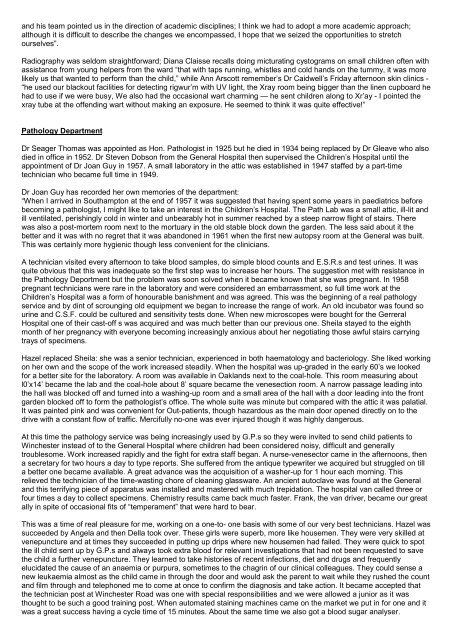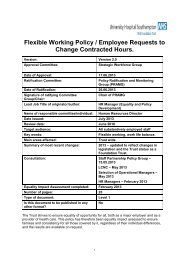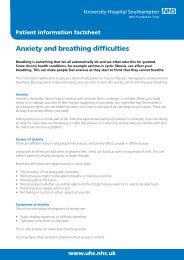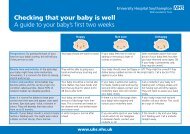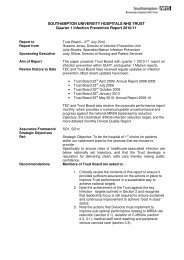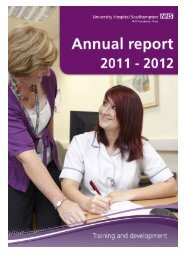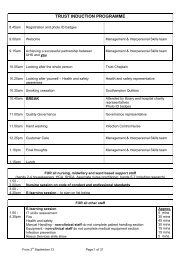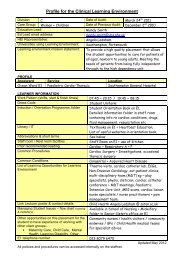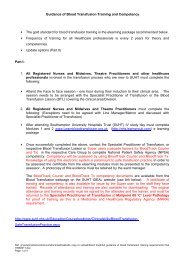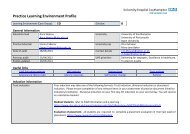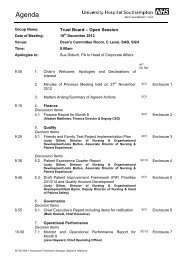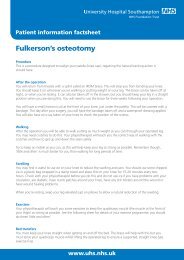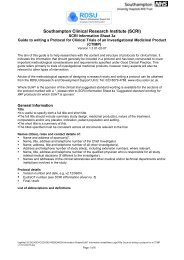ninety years of service - University Hospital Southampton NHS ...
ninety years of service - University Hospital Southampton NHS ...
ninety years of service - University Hospital Southampton NHS ...
- No tags were found...
Create successful ePaper yourself
Turn your PDF publications into a flip-book with our unique Google optimized e-Paper software.
and his team pointed us in the direction <strong>of</strong> academic disciplines; I think we had to adopt a more academic approach;although it is difficult to describe the changes we encompassed, I hope that we seized the opportunities to stretchourselves”.Radiography was seldom straightforward; Diana Claisse recalls doing micturating cystograms on small children <strong>of</strong>ten withassistance from young helpers from the ward “that with taps running, whistles and cold hands on the tummy, it was morelikely us that wanted to perform than the child,” while Ann Arscott remember’s Dr Caidwell’s Friday afternoon skin clinics -“he used our blackout facilities for detecting rigwur’m with UV light, the Xray room being bigger than the linen cupboard hehad to use if we were busy, We also had the occasional wart charming — he sent children along to Xr’ay - I pointed thexray tube at the <strong>of</strong>fending wart without making an exposure. He seemed to think it was quite effective!”Pathology DepartmentDr Seager Thomas was appointed as Hon. Pathologist in 1925 but he died in 1934 being replaced by Dr Gleave who alsodied in <strong>of</strong>fice in 1952. Dr Steven Dobson from the General <strong>Hospital</strong> then supervised the Children’s <strong>Hospital</strong> until theappointment <strong>of</strong> Dr Joan Guy in 1957. A small laboratory in the attic was established in 1947 staffed by a part-timetechnician who became full time in 1949.Dr Joan Guy has recorded her own memories <strong>of</strong> the department:“When I arrived in <strong>Southampton</strong> at the end <strong>of</strong> 1957 it was suggested that having spent some <strong>years</strong> in paediatrics beforebecoming a pathologist, l might like to take an interest in the Children’s <strong>Hospital</strong>. The Path Lab was a small attic, ill-lit andill ventilated, perishingly cold in winter and unbearably hot in summer reached by a steep narrow flight <strong>of</strong> stairs. Therewas also a post-mortem room next to the mortuary in the old stable block down the garden. The less said about it thebetter and it was with no regret that it was abandoned in 1961 when the first new autopsy room at the General was built.This was certainly more hygienic though less convenient for the clinicians.A technician visited every afternoon to take blood samples, do simple blood counts and E.S.R.s and test urines. It wasquite obvious that this was inadequate so the first step was to increase her hours. The suggestion met with resistance inthe Pathology Deportment but the problem was soon solved when it became known that she was pregnant. In 1958pregnant technicians were rare in the laboratory and were considered an embarrassment, so full time work at theChildren’s <strong>Hospital</strong> was a form <strong>of</strong> honourable banishment and was agreed. This was the beginning <strong>of</strong> a real pathology<strong>service</strong> and by dint <strong>of</strong> scrounging old equipment we began to increase the range <strong>of</strong> work. An old incubator was found sourine and C.S.F. could be cultured and sensitivity tests done. When new microscopes were bought for the Gerreral<strong>Hospital</strong> one <strong>of</strong> their cast-<strong>of</strong>f s was acquired and was much better than our previous one. Sheila stayed to the eighthmonth <strong>of</strong> her pregnancy with everyone becoming increasingly anxious about her negotiating those awful stairs carryingtrays <strong>of</strong> specimens.Hazel replaced Sheila: she was a senior technician, experienced in both haematology and bacteriology. She liked workingon her own and the scope <strong>of</strong> the work increased steadily. When the hospital was up-graded in the early 60’s we lookedfor a better site for the laboratory. A room was available in Oaklands next to the coal-hole. This room measuring aboutl0’x14’ became the lab and the coal-hole about 8’ square became the venesection room. A narrow passage leading intothe hall was blocked <strong>of</strong>f and turned into a washing-up room and a small area <strong>of</strong> the hall with a door leading into the frontgarden blocked <strong>of</strong>f to form the pathologist’s <strong>of</strong>fice. The whole suite was minute but compared with the attic it was palatial.It was painted pink and was convenient for Out-patients, though hazardous as the main door opened directly on to thedrive with a constant flow <strong>of</strong> traffic. Mercifully no-one was ever injured though it was highly dangerous.At this time the pathology <strong>service</strong> was being increasingly used by G.P.s so they were invited to send child patients toWinchester instead <strong>of</strong> to the General <strong>Hospital</strong> where children had been considered noisy, difficult and generallytroublesome. Work increased rapidly and the fight for extra staff began. A nurse-venesector came in the afternoons, thena secretary for two hours a day to type reports. She suffered from the antique typewriter we acquired but struggled on tilla better one became available. A great advance was the acquisition <strong>of</strong> a washer-up for 1 hour each morning. Thisrelieved the technician <strong>of</strong> the time-wasting chore <strong>of</strong> cleaning glassware. An ancient autoclave was found at the Generaland this terrifying piece <strong>of</strong> apparatus was installed and mastered with much trepidation. The hospital van called three orfour times a day to collect specimens. Chemistry results came back much faster. Frank, the van driver, became our greatally in spite <strong>of</strong> occasional fits <strong>of</strong> “temperament” that were hard to bear.This was a time <strong>of</strong> real pleasure for me, working on a one-to- one basis with some <strong>of</strong> our very best technicians. Hazel wassucceeded by Angela and then Della took over. These girls were superb, more like housemen. They were very skilled atvenepuncture and at times they succeeded in putting up drips where new housemen had failed. They were quick to spotthe ill child sent up by G.P.s and always took extra blood for relevant investigations that had not been requested to savethe child a further venepuncture. They learned to take histories <strong>of</strong> recent infections, diet and drugs and frequentlyelucidated the cause <strong>of</strong> an anaemia or purpura, sometimes to the chagrin <strong>of</strong> our clinical colleagues. They could sense anew leukaemia almost as the child came in through the door and would ask the parent to wait while they rushed the countand film through and telephoned me to come at once to confirm the diagnosis and take action. It became accepted thatthe technician post at Winchester Road was one with special responsibilities and we were allowed a junior as it wasthought to be such a good training post. When automated staining machines came on the market we put in for one and itwas a great success having a cycle time <strong>of</strong> 15 minutes. About the same time we also got a blood sugar analyser.


